Cook Islands
Coordinates: 21°14′S 159°46′W / 21.233°S 159.767°W
| Cook Islands Kūki 'Āirani |
||||||
|---|---|---|---|---|---|---|
|
||||||
| Anthem: Te Atua Mou E God is Truth |
||||||
.svg.png) |
||||||
| Status | Area of the Realm of New Zealand and Associated State |
|||||
| Capital and largest city | Avarua 21°12′S 159°46′W / 21.200°S 159.767°W | |||||
| Official languages |
|
|||||
| Spoken languages | ||||||
| Ethnic groups ([1] ) |
|
|||||
| Demonym | Cook Islander | |||||
| Government | Constitutional monarchy | |||||
| • | Monarch | Elizabeth II | ||||
| • | Queen's Representative | Tom Marsters | ||||
| • | Prime Minister | Henry Puna | ||||
| Legislature | Parliament | |||||
| Associated state | ||||||
| • | Self-government in free association with New Zealand | 4 August 1965 | ||||
| • | UN recognition of independence in foreign relations | 1992[2] | ||||
| Area | ||||||
| • | Total | 240 km2 (210th) 91 sq mi |
||||
| Population | ||||||
| • | 2011[3] census | 14,974 | ||||
| • | Density | 42/km2 (124th) 111/sq mi |
||||
| GDP (PPP) | 2005 estimate | |||||
| • | Total | $183.2 million (not ranked) | ||||
| • | Per capita | $9,100 (not ranked) | ||||
| Currency | New Zealand dollar (NZD)Cook Islands dollar |
|||||
| Time zone | CKT (UTC-10) | |||||
| Drives on the | left | |||||
| Calling code | 682 | |||||
| ISO 3166 code | CK | |||||
| Internet TLD | .ck | |||||
The Cook Islands (![]() i/ˈkʊk ˈaɪləndz/; Cook Islands Māori: Kūki 'Āirani)[4] is a self-governing island country in the South Pacific Ocean in free association with New Zealand. It comprises 15 islands whose total land area is 240 square kilometres (92.7 sq mi). The Cook Islands' Exclusive Economic Zone (EEZ), however, covers 1,800,000 square kilometres (690,000 sq mi) of ocean.[5]
i/ˈkʊk ˈaɪləndz/; Cook Islands Māori: Kūki 'Āirani)[4] is a self-governing island country in the South Pacific Ocean in free association with New Zealand. It comprises 15 islands whose total land area is 240 square kilometres (92.7 sq mi). The Cook Islands' Exclusive Economic Zone (EEZ), however, covers 1,800,000 square kilometres (690,000 sq mi) of ocean.[5]
The Cook Islands' defence and foreign affairs are the responsibility of New Zealand, but they are exercised in consultation with the Cook Islands. In recent times, the Cook Islands have adopted an increasingly independent foreign policy. Although Cook Islanders are citizens of New Zealand, they have the status of Cook Islands nationals, which is not given to other New Zealand citizens.
The Cook Islands' main population centres are on the island of Rarotonga (10,572 in 2011),[3] where there is an international airport. There is a larger population of Cook Islanders in New Zealand, particularly the North Island. In the 2006 census, 58,008 self-identified as being of ethnic Cook Islands Māori descent.[6]
With about 100,000 visitors travelling to the islands in the 2010–11 financial year,[7] tourism is the country's main industry, and the leading element of the economy, ahead of offshore banking, pearls, and marine and fruit exports.
Geography
The Cook Islands are in the South Pacific Ocean, northeast of New Zealand, between French Polynesia and American Samoa. There are 15 major islands spread over 2,200,000 km2 (849,425 sq mi) of ocean, divided into two distinct groups: the Southern Cook Islands and the Northern Cook Islands of coral atolls.[8]
The islands were formed by volcanic activity; the northern group is older and consists of six atolls, which are sunken volcanoes topped by coral growth. The climate is moderate to tropical.

The 15 islands and two reefs are grouped as follows:
- Southern Cook Islands:
- Nga-pu-Toru ("Three Roots", the eastern islands):
- Northern Cook Islands:
- Other islands:
- Aitutaki (Araura Enua)
- Mangaia (Auau Enua)
- Rarotonga (Tumutevarovaro), with the capital, Avarua.
- Palmerston Island (Pamati) sometimes grouped with the Northern Group.
- Manuae
- Winslow Reef (submerged)

History

The Cook Islands were first settled in the 6th century by Polynesian people who migrated from Tahiti,[9] an island 1,154 kilometres (717 mi) to the northeast.
Spanish ships visited the islands in the 16th century; the first written record of contact with the islands came in 1595 with the sighting of Pukapuka by Spanish sailor Álvaro de Mendaña de Neira, who called it San Bernardo (Saint Bernard). Pedro Fernandes de Queirós, a Portuguese captain working for the Spanish crown, made the first recorded European landing in the islands when he set foot on Rakahanga in 1606, calling it Gente Hermosa (Beautiful People).[10]
British navigator Captain James Cook arrived in 1773 and 1777[11] and named the islands the Hervey Islands; the name "Cook Islands", in honour of Cook, appeared on a Russian naval chart published in the 1820s.[12]
In 1813 John Williams, a missionary on the Endeavour (not the same ship as Cook's) made the first recorded sighting of Rarotonga.[13] The first recorded landing on Rarotonga by Europeans was in 1814 by the Cumberland; trouble broke out between the sailors and the Islanders and many were killed on both sides.[14] The islands saw no more Europeans until missionaries arrived from England in 1821. Christianity quickly took hold in the culture and many islanders continue to be Christian believers today.

The Cook Islands became a British protectorate in 1888, due largely to community fears that France might occupy the territory as it had Tahiti. On 6 September 1900, the leading islanders presented a petition asking that the islands (including Niue "if possible") should be annexed as British territory.[15][16] On 8–9 October 1900 seven instruments of cession of Rarotonga and other islands were signed by their chiefs and people; and by a British Proclamation issued at the same time the cessions were accepted, the islands being declared parts of Her Britanic Majesty's dominions.[15] These instruments did not include Aitutaki. It appears that, though the inhabitants regarded themselves as British subjects, the Crown's title was uncertain, and the island was formally annexed by Proclamation dated 9 October 1900.[17][18] The islands were included within the boundaries of the Colony of New Zealand in 1901 by Order in Council[19] under the Colonial Boundaries Act, 1895 of the United Kingdom.[15][20] The boundary change became effective on 11 June 1901 and the Cook Islands have had a formal relationship with New Zealand ever since.[15]
When the British Nationality and New Zealand Citizenship Act 1948 came into effect on 1 January 1949, Cook Islanders who were British subjects gained New Zealand citizenship.[21] The country remained a New Zealand dependent territory until 1965, when the New Zealand Government decided to offer self-governing status to its colony. In that year, Albert Henry of the Cook Islands Party was elected as the first Premier. Henry led the country until he was accused of vote-rigging. He was succeeded in 1978 by Tom Davis of the Democratic Party.
Politics and foreign relations
The Cook Islands is a representative democracy with a parliamentary system in an associated state relationship with New Zealand. Executive power is exercised by the government, with the Chief Minister as head of government. Legislative power is vested in both the government and the Parliament of the Cook Islands. There is a pluriform multi-party system. The Judiciary is independent of the executive and the legislature. The head of state is the Queen of New Zealand, who is represented in the Cook Islands by the Queen's Representative.
The islands are self-governing in "free association" with New Zealand. New Zealand retains primary responsibility for external affairs, with consultation with the Cook Islands government. Cook Islands nationals are citizens of New Zealand and can receive New Zealand government services, but the reverse is not true; New Zealand citizens are not Cook Islands nationals. Despite this, as of 2014, the Cook Islands had diplomatic relations in its own name with 43 other countries. The Cook Islands is not a United Nations member state, but, along with Niue, has had their "full treaty-making capacity" recognised by United Nations Secretariat,[22][23] and is a full member of the WHO and UNESCO UN specialised agencies, is an associate member of the Economic and Social Commission for Asia and the Pacific (UNESCAP) and a Member of the Assembly of States of the International Criminal Court.
On 11 June 1980, the United States signed a treaty with the Cook Islands specifying the maritime border between the Cook Islands and American Samoa and also relinquishing any American claims to Penrhyn, Pukapuka, Manihiki, and Rakahanga.[24] In 1990 the Cook Islands and France signed a treaty that delimited the boundary between the Cook Islands and French Polynesia.[25] As competition between the US and China heated up in the South China Sea and other areas closer to the mainland, the Cook Islands began to feel the results. In late August 2012, for instance, United States Secretary of State Hillary Clinton visited the islands.[26][27]
Administrative subdivisions
There are island councils on all of the inhabited outer islands (Outer Islands Local Government Act 1987 with amendments up to 2004, and Palmerston Island Local Government Act 1993) except Nassau, which is governed by Pukapuka (Suwarrow, with only one caretaker living on the island, also governed by Pukapuka, is not counted with the inhabited islands in this context). Each council is headed by a mayor.
- The Ten Outer Islands Councils are
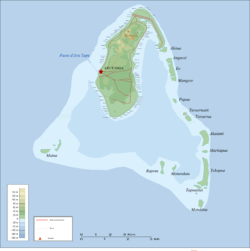 |
 |
Aitutaki (including uninhabited Manuae) |
 |
 |
Atiu (including uninhabited Takutea) |
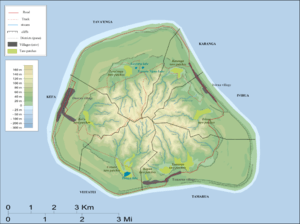 |
Mangaia | |
 |
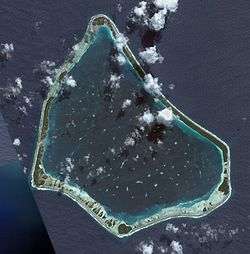 |
Manihiki |
 |
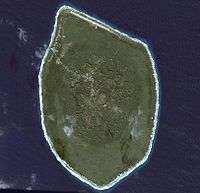 |
Ma'uke |
 |
 |
Mitiaro |
 |
 |
Palmerston |
 |
 |
Penrhyn |
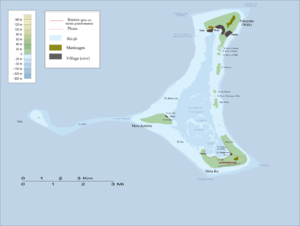 |
Pukapuka (including Nassau and Suwarrow) | |
 |
 |
Rakahanga |

The three Vaka councils of Rarotonga established in 1997 (Rarotonga Local Government Act 1997), also headed by mayors,[28] were abolished in February 2008, despite much controversy.[29][30]
- The three Vaka councils on Rarotonga were:
| Te-Au-O-Tonga | (equivalent to Avarua, the capital of the Cook Islands) |
| Puaikura | Arorangi |
| Takitumu | Matavera, Ngatangiia, Takitumu |
On the lowest level, there are village committees. Nassau, which is governed by Pukapuka, has an island committee (Nassau Island Committee), which advises the Pukapuka Island Council on matters concerning its own island.
Demographics
| Population pyramid 2011[31] | ||||
| % | Males | Age | Females | % |
| 0 | 85+ | 0 | ||
| 0.5 | 80–84 | 0.6 | ||
| 0.7 | 75–79 | 0.9 | ||
| 1.4 | 70–74 | 1.4 | ||
| 1.9 | 65–69 | 1.8 | ||
| 2.2 | 60–64 | 2 | ||
| 2.4 | 55–59 | 2.4 | ||
| 3 | 50–54 | 3 | ||
| 3.6 | 45–49 | 3.6 | ||
| 3.4 | 40–44 | 3.6 | ||
| 3.1 | 35–39 | 3.6 | ||
| 3 | 30–34 | 3.3 | ||
| 3.3 | 25–29 | 3.8 | ||
| 3.4 | 20–24 | 3.7 | ||
| 4.3 | 15–19 | 4.1 | ||
| 4.5 | 10–14 | 4 | ||
| 4.3 | 5–9 | 4.3 | ||
| 4.5 | 0–4 | 4.4 | ||
Births and deaths [32]
| Year | Population | Live births | Deaths | Natural increase | Crude birth rate | Crude death rate | Rate of natural increase | TFR |
|---|---|---|---|---|---|---|---|---|
| 2009 | 284 | 72 | 212 | 12.6 | 3.2 | 9.4 | ||
| 2010 | 286 | 92 | 194 | 12.1 | 3.9 | 8.2 | ||
| 2011 | 14 974 | 262 | 72 | 190 | 13.6 | 3.7 | 9.8 | |
| 2012 | 259 | 104 | 155 | 13.3 | 5.3 | 7.9 | ||
| 2013 | 256 | 115 | 141 | 13.8 | 6.2 | 7.6 | ||
Economy
The economy is strongly affected by geography. It is isolated from foreign markets, and has some inadequate infrastructure; it lacks major natural resources, has limited manufacturing and suffers moderately from natural disasters. Tourism provides the economic base which makes up approximately 67.5% of GDP. Additionally, the economy is supported by foreign aid, largely from New Zealand. The Peoples' Republic of China has also contributed foreign aid which has resulted in, among other projects, the Police Headquarters building. The Cook Islands is expanding its agriculture, mining and fishing sectors, with varying success.
Since approximately 1989, the Cook Islands have become a location specialising in so-called asset protection trusts, by which investors shelter assets from the reach of creditors and legal authorities.[33][34] According to The New York Times, the Cooks have "laws devised to protect foreigners' assets from legal claims in their home countries" which were apparently crafted specifically to thwart the long arm of American justice; creditors must travel to the Cook Islands and argue their cases under Cooks law, often at prohibitive expense.[33] Unlike other foreign jurisdictions such as the British Virgin Islands, the Cayman Islands and Switzerland, the Cooks "generally disregard foreign court orders" and do not require that bank accounts, real estate, or other assets protected from scrutiny (it is illegal to disclose names or any information about Cooks trusts) be physically located within the archipelago.[33] Taxes on trusts and trust employees account for some 8% of the Cook Islands economy, behind tourism but ahead of fishing.[33]
In recent years, the Cook Islands has gained a reputation as a debtor paradise, through the enactment of legislation which permits debtors to shield their property from the claims of creditors.[35]
Culture
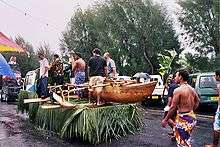
Language
The languages of the Cook Islands include English, Cook Islands Māori, or "Rarotongan," and Pukapukan. Dialects of Cook Islands Maori include Penrhyn; Rakahanga-Manihiki; the Ngaputoru dialect of Atiu, Mitiaro, and Mauke; the Aitutaki dialect; and the Mangaian dialect. Cook Islands Maori and its dialectic variants are closely related to both Tahitian and to New Zealand Māori. Pukapukan is considered closely related to the Samoan language. English and Cook Islands Maori are official languages of the Cook Islands.
Music
Music in the Cook Islands is varied, with Christian songs being quite popular, but traditional dancing and songs in Polynesian languages remain popular.

Public holidays
| Date | Name |
|---|---|
| 1 January | New Year's Day |
| 2 January | Day after New Year's Day |
| The Friday before Easter Sunday | Good Friday |
| The day after Easter Sunday | Easter Monday |
| 25 April | ANZAC Day |
| The first Monday in June | Queen's Birthday |
| During July | Rarotonga Gospel Day |
| 4 August | Constitution Day (Te Maevea Nui Celebrations) |
| 26 October | Gospel Day |
| 25 December | Christmas |
| 26 December | Boxing Day |
Art
Carving
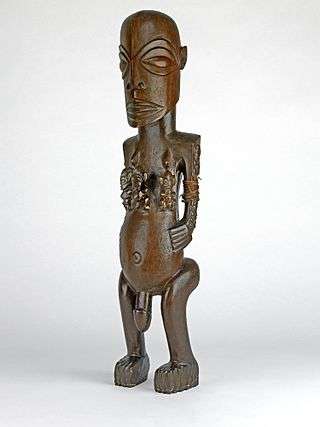
Woodcarving is a common art form in the Cook Islands. The proximity of islands in the southern group helped produce a homogeneous style of carving but which had special developments in each island. Rarotonga is known for its fisherman's gods and staff-gods, Atiu for its wooden seats, Mitiaro, Mauke and Atiu for mace and slab gods and Mangaia for its ceremonial adzes. Most of the original wood carvings were either spirited away by early European collectors or were burned in large numbers by missionaries. Today, carving is no longer the major art form with the same spiritual and cultural emphasis given to it by the Maori in New Zealand. However, there are continual efforts to interest young people in their heritage and some good work is being turned out under the guidance of older carvers. Atiu, in particular, has a strong tradition of crafts both in carving and local fibre arts such as tapa. Mangaia is the source of many fine adzes carved in a distinctive, idiosyncratic style with the so-called double-k design. Mangaia also produces food pounders carved from the heavy calcite found in its extensive limestone caves.[37]
Weaving
The outer islands produce traditional weaving of mats, basketware and hats. Particularly fine examples of rito hats are worn by women to church. They are made from the uncurled immature fibre of the coconut palm and are of very high quality. The Polynesian equivalent of Panama hats, they are highly valued and are keenly sought by Polynesian visitors from Tahiti. Often, they are decorated with hatbands made of minuscule pupu shells which are painted and stitched on by hand. Although pupu are found on other islands the collection and use of them in decorative work has become a speciality of Mangaia. The weaving of rito is a speciality of the northern island of Penrhyn.[38]
Tivaevae
A major art form in the Cook Islands is tivaevae. This is, in essence, the art of handmade Island scenery patchwork quilts. Introduced by the wives of missionaries in the 19th century, the craft grew into a communal activity and is probably one of the main reasons for its popularity.[39]
Contemporary art
The Cook Islands has produced internationally recognised contemporary artists, especially in the main island of Rarotonga. Artists include painter (and photographer) Mahiriki Tangaroa, sculptors Eruera (Ted) Nia (originally a film maker) and master carver Mike Tavioni, painter (and Polynesian tattoo enthusiast) Upoko'ina Ian George, Aitutakian-born painter Tim Manavaroa Buchanan, Loretta Reynolds, Judith Kunzlé, Joan Rolls Gragg, Kay George (who is also known for her fabric designs), Apii Rongo, Varu Samuel, and multi-media, installation and community-project artist Ani O'Neill, all of whom currently live on the main island of Rarotonga. Atiuan-based Andrea Eimke is an artist who works in the medium of tapa and other textiles, and also co-authored the book 'Tivaivai – The Social Fabric of the Cook Islands' with British academic Susanne Kuechler. Many of these artists have studied at university art schools in New Zealand and continue to enjoy close links with the New Zealand art scene.[40]
New Zealand-based Cook Islander artists include Michel Tuffery, print-maker David Teata, Richard Shortland Cooper, Sylvia Marsters and Jim Vivieaere.
On Rarotonga, the main commercial galleries are Beachcomber Contemporary Art (Taputapuatea, Avarua) run by Ben & Trevon Bergman,[41] and The Art Studio Gallery (Arorangi) run by Ian and Kay George.[42] The Cook Islands National Museum also exhibits art.[43]
Wildlife
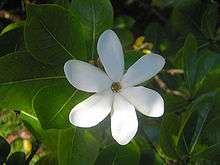
- The national flower of the Cook Islands is the Tiare māori or Tiale māoli (Penrhyn, Nassau, Pukapuka).[44]
- The Cook Islands have a large non-native population of Kiore toka (Ship rat).[45] and Polynesian rat.[46] The rats have dramatically reduced the bird population on the islands.[47]
- In April 2007, 27 Kuhl's lorikeet were re-introduced to Atiu from Rimatara. Fossil and oral traditions indicate that the species was formerly on at least five islands of the southern group. Excessive exploitation for its red feathers is the most likely reason for the species's extinction in the Cook Islands.[48]
Sport
Rugby league is the most popular sport in the Cook Islands.[49] Rugby union, Association football (soccer), Netball, and Cricket are also popular.
See also
- Outline of the Cook Islands
- Index of Cook Islands-related articles
- Demographics of the Cook Islands
- List of islands
References
- ↑ Cook Islands. CIA World Fact Book
- ↑ UN THE WORLD TODAY (PDF) and Repertory of Practice of United Nations Organs Supplement No. 8; page 10 Archived 19 October 2013 at the Wayback Machine.
- 1 2 "Cook Islands 2011 census". Retrieved 22 March 2015.
- ↑ Cook Islands Maori dictionary by Jasper Buse & Raututi Taringa, Cook Islands Ministry of Education (1995) page 200
- ↑ A View from the Cook Islands. SOPAC
- ↑ "QuickStats About Culture and Identity – Pacific Peoples". 2006 Census. Statistics New Zealand. Archived from the original on 29 August 2007. Retrieved 12 June 2007.
- ↑ "The Cook Islands Half Year Economic and Fiscal Update For the Financial Year 2010/2011" (PDF). Cook Islands Ministry of Finance & Economic Management. December 2010. p. 7.
- ↑ "Cook Islands Travel Guide" (with description), World Travel Guide, Nexus Media Communications, 2006. Webpage: WTGuide-Cook-Islands.
- ↑ Cook Islands (archived from the original on 19 March 2012).
- ↑ Hooker, Brian (1998). "European discovery of the Cook Islands". Terrae Incognitae. 30. pp. 54–62.
- ↑ Thomas, Nicholas (2003). Cook : the extraordinary voyages of Captain James Cook, Walker & Company, ISBN 0802714129, pp. 310–311.
- ↑ "Cook Islands Government website". Cook-islands.gov.ck. Archived from the original on 26 March 2009. Retrieved 18 November 2011.
- ↑ "Ten Decades: The Australasian Centenary History of the London Missionary Society, Rev. Joseph King (Word document)". Retrieved 18 November 2011.
- ↑ "History of the Cook Islands". Ck. Retrieved 18 November 2011.
- 1 2 3 4 "Commonwealth and Colonial Law" by Kenneth Roberts-Wray, London, Stevens, 1966. P. 891
- ↑ N.Z. Parliamentary Pp., A3 (1901)
- ↑ "Commonwealth and Colonial Law" by Kenneth Roberts-Wray, London, Stevens, 1966. P. 761
- ↑ N.Z. Parliamentary Pp., A1 (1900)
- ↑ S.R.O. & S.I. Rev. XVI, 862–863
- ↑ 58 & 59 V. c. 34.
- ↑ 3. Aliens and citizens – Citizenship – Te Ara Encyclopedia of New Zealand. Teara.govt.nz (4 March 2009). Retrieved 26 December 2012.
- ↑ "Organs Supplement", Repertory of Practice (PDF) (8), UN, p. 10, archived from the original (PDF) on 19 October 2013
- ↑ The World today (PDF), UN
- ↑ "Treaty Between the United States of America and the Cook Islands on Friendship and Delimitation of the Maritime Boundary Between the United States of America and the Cook Islands (and Exchange of Notes)". Pacific Islands Treaty Series. University of the South Pacific School of Law. Retrieved 18 May 2009.
- ↑ "Agreement on Maritime Delimitation Between the Government of the Cook Islands and the Government of the French Republic". Pacific Islands Treaty Series. University of the South Pacific School of Law. Retrieved 4 March 2010.
- ↑ "Secretary Clinton:Travel to the Cook Islands, Indonesia, China, Timor-Leste, Brunai, and Russia". U.S. Department of State. Retrieved 4 September 2012.
- ↑ Richter, Paul (29 August 2012). "Hillary Clinton's visit underscores new value of Cook Islands". Los Angeles Times. Retrieved 29 August 2012.
- ↑ Larmour, Peter and Barcham, Manuhuia. Cook Islands 2004, Transparency International Country Study Report.
- ↑ "Rarotonga Local Government (Repeal) Bill To Be Tabled, Cook Islands Government". Cook-islands.gov.ck. Retrieved 17 October 2013.
- ↑ Minister asked to answer queries over abolition of Vaka Councils. The Cook Islands Herald, No. 393 (9 February 2008)
- ↑ "Demographic Yearbook, Population by age, sex and urban/rural residence: latest available year, 2005–2014" (PDF). UN Data. United Nations. Retrieved 4 December 2015.
- ↑ http://unstats.un.org/unsd/demographic/products/dyb/dyb2.htm
- 1 2 3 4 Wayne, Leslie. Cook Islands, a Paradise of Untouchable Assets, The New York Times, 14 December 2013. Retrieved 27 December 2013.
- ↑ Rosen, Howard; Donlevy-Rosen, Patricia. "Review of Offshore Jurisdictions: Cook Islands". The Asset Protection News.
- ↑ http://www.nytimes.com/2013/12/15/business/international/paradise-of-untouchable-assets.html?_r=0
- ↑ Highlights. British Museum
- ↑ "Lords of the Dance – Culture of the Cook Islands: Visual Arts". Retrieved 2016-04-08.
- ↑ "Lords of the Dance – Culture of the Cook Islands: Crafts". Retrieved 2016-04-08.
- ↑ "Tivaevae – Quilts of the Cook Islands". Retrieved 2016-04-08.
- ↑ "The Cook Islands Arts Community". cookislandsarts.com. Retrieved 2016-04-08.
- ↑ "BCA Gallery, Rarotonga". Retrieved 2016-04-08.
- ↑ "Ian George – Tutai – Guiding Pacific Arts". Retrieved 2016-04-08.
- ↑ "Cook Islands Museum and Library Society". Retrieved 2016-04-08.
- ↑ "Cook Islands Wildlife". govisitcookislands.com.
- ↑ "Cook Islands Biodiversity: Rattus rattus – Ship Rat". Cookislands.bishopmuseum.org. Retrieved 18 November 2011.
- ↑ "Cook Islands Biodiversity: Rattus exulans – Pacific Rat". Cookislands.bishopmuseum.org. Retrieved 18 November 2011.
- ↑ "Cook Islands Biodiversity: The Status of Cook Islands Birds – 1996". Cookislands.bishopmuseum.org. 24 September 2005. Retrieved 18 November 2011.
- ↑ "BirdLife International: Rimatara Lorikeet (Vini kuhlii) at". Birdlife.org. Retrieved 18 November 2011.
- ↑ "Cook Islands Financial Strife". We Are Rugby. Archived from the original on 6 December 2011.
Further reading
- Gilson, Richard. The Cook Islands 1820–1950. Wellington, New Zealand: Victoria University Press, 1980. ISBN 0-7055-0735-1
External links
- Official website Cook Islands Government
- Chief of State and Cabinet Members
- "Cook Islands". The World Factbook. Central Intelligence Agency.
- Cook Islands from UCB Libraries GovPubs
- Cook Islands at DMOZ
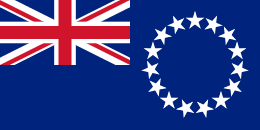

.svg.png)
